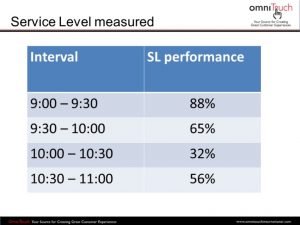
Recently, a Global Call Centre benchmarking report made the rounds, stating that the industry standard average call centre abandonment rate was 12%.
It could have said 22%, 2% or even 82% and the report still wouldn’t have been that helpful.
But it was the long thread of comments that struck me.
The tone ranged from mild annoyance – “This just can’t be…The sample size is too small…How do they calculate…” – through to the kind of responses you’d expect from an extinction-level event and return of the dinosaurs.
“They should all lose their jobs!…
“You have to be where your Customers are!…”
“Off with their heads!” (ok that last one was mine).
Oh, and for my Australian readers, the latest industry report suggested 5.5% was the average call centre abandonment rate and the average wait time in queue was 1 minute 40 seconds.
If your centre generates revenue – you can stop reading now
Clearly, if you’re in the revenue generation business – the abandonment rate matters – a lot.
We had a Client in the hospitality business that calculated that every 1% increase in abandonment rate represented a potential US$1,000,000 in lost hotel bookings worldwide.
So if you’re DHL, a major hotel chain or even McDonalds delivery – and your Customers still call you to place orders – you have to care.
But if you’re in Technical Support or Customer Care, the importance of Abandonment Rate on the overall performance dashboard is secondary at best.
You are invited to read on.
The best & primary metric to measure the Customer’s wait time experience? Service Level
Mastery of interval-based Service Level performance is where your control lies.
The process for planning and managing Frontline resources to ensure consistent wait time experiences for Customers is well understood and well documented.
Whether you’re 90/10, 80/30 or 70/160, having the right number of people in the right place at the right time is the objective.
That’s how organizations plan for and manage labour cost as well as deliver a consistent Customer experience for wait time.
Why Intervals matter
Most mid to larger Centres plan, staff and manage down to hourly, half-hourly and even 15-minute intervals.

If the Service Level goes down during any interval – let’s say from 10:00 – 10:30 in the example shown here – the Customer wait time during that interval increases.
And as Customer wait time increases – that’s likely to have an impact on the Abandonment Rate for that interval.
Makes sense doesn’t it.
If I don’t perform to my Service Level objectives then my Customer Wait time goes up, and my Abandonment Rate will likely go up too.
In this situation, you don’t have an Abandonment Rate issue – you have a Service Level issue.
When your Service Level life is good
Operations professionals know that when interval-based Service Level is well managed, there are significant positive impacts across Quality, Engagement and the Customer Experience.
And when your Service Level objectives are being met – interval after interval – then my inner operations guru reminds me that Abandonment Rate will be what it will be.
Abandonment Rate flows from a combination of your Service Level performance – which is in your control – and your Customer behaviour – which is not.
Let’s make one point very clear.
An accurate discussion on Abandonment – whether yours or that of others – has to be predicated on the understanding that interval-based Service Level objectives are being met.
If they’re not being met, then you need to have an entirely different conversation.
I’m not sure that any of these ‘benchmarking’ studies make that prerequisite clear. And that limits their effectiveness.
Back to revenue-generating Centres for a moment
If you’re in revenue generation you have to care. Abandonment costs potential revenue.
But what the smart folks in revenue generation do is set very high Service Level objectives.
Then they work hard to meet them interval after interval.
95/5, 90/10, 100/15 – this level of Service Level objectives is typically associated with revenue-generating call centres – or those that deal with life & death or mission-critical issues.
Sure – more staff will be required.
Through the use of ‘incremental revenue analysis’, the additional cost of labour is calculated and measured against revenue gained through the reduction in Abandonment Rate (via quicker answering times).
That was a mouthful.
Customers & Call Centre Abandonment rate
For non-revenue generating Centres we need to consider – what are the drivers of Customers hanging up before reaching the Agent?
Here are some common drivers:
- Degree of importance – how important is it for me to get this done ‘right now’?
- Time available to wait – am I calling from work where my time is limited? Or am I calling from the comfort of my easy chair when I’m home?
- What other options do I have? – can I get what I want from the website? Perhaps the mobile app? Did you share an alternative method on your delay announcement?
- What kind of mood am I in? – Relaxed? Impatient? Calm? Anxious?
- What are my expectations? – Am I a VIP? Is this a premiere line? Do I hold some special status?
When I work with Contact Centre management in classes I ask – “Is Abandonment Rate a mathematical behaviour? Or is it a human behaviour?”
Invariably, they answer correctly.
Abandonment Rate is a human behaviour.
It lies in the hands of the customer – what they want or need at that moment, their mood, their options, their expectations.
What I can control is how well I plan, staff and manage to meet my Service Level objective interval after interval.
What I can’t control is their mood, their unique expectations, what options we offer for digital self-care.
But you do have a viable option
If you are still unhappy about the ‘level’ or number of abandoned calls you receive – you can choose to raise your Service Level objective.
Go from 80/20 to 90/20.
Do the delay profile analysis against abandonment rate patterns to see how many abandons you can possibly do away with.
I’ve even seen Centres proactively raise their Service Level objective for certain intervals across the day.
You just have to ask yourself a classic trade-off question.
Is the increased cost of my labour pool justified by the reduction in Abandonment Rate?
Or more generically: Does the benefit exceed the cost?
Not a simple question to answer – but absolutely the right question to ask.
Let’s get formal about it
There are a lot of metrics in a Centre – and some great ways to look at how to classify them and understand their inter-relationships.
Formally, Call Centre Abandonment Rate is best classified as a secondary measure of Wait Time.
Wait Time: Because along with metrics like Service Level, Response Time, Longest Wait Time and Average Speed of Answer, Abandonment Rate reflects wait time.
Secondary: Some metrics are drivers, some metrics are outcomes. Abandonment Rate is an outcome of the ‘driver’ of Service Level.
You can’t achieve a Service Level objective and an Abandonment Rate objective at the same time – simply because one is a driver and the other is an outcome.
You tell me you can? That you are? That you have been for some time?
Then you’re just lucky.
The targets set just happened to work out. There’s nothing scientific going on here.
What interests me more
The most mature organizations – again in Customer Care & Technical Support – look at Abandonment Rate this way.
They say things like:
- We don’t target Abandonment Rate – but we study it.
- We look for and find patterns to Abandonment Rate – we know which intervals across the day tend to experience higher or lower rates of abandonment when achieving Service Level.
- We don’t just study how many abandons we get, nor even the percentage – we like to study the distribution. Do most hang up in the first 15 seconds or so? What percentage of abandonment comes after 3 minutes (for example) vs. less than 3 minutes?
- We’re experimenting with our messaging to understand if our messages contribute to abandonment (which can be good!) or if we need to change the timing or positioning of such messages to try and influence abandonment.
Agents & Abandonment rate
No – your Agents don’t control the Abandonment rate – sorry but that’s just silly.
When you use accepted practices to calculate and schedule the number of Agents you need in place to achieve a predetermined Service Level and those Agents are actually there, logged in and part of Capacity – they’re contributing to Service Level performance.
I met a Client some years back, that intentionally managed their Centre based on Abandonment Rate as a primary metric – not Service Level.
But focus groups with Middle Management and the Frontline revealed the level of extreme stress these folks experienced.
Because you can’t plan and staff to Abandonment Rate – it’s driven by Customer/human behaviour.
And that behaviour fluctuates from interval to interval, day to day.
So they operated like a fire-fighting outfit – chasing constant flare-ups in abandoned calls.
How stressful.
And ultimately not the right way to achieve Customer Experience.
In closing
One of the most important tenets of Customer Experience is to deliver a consistent experience.
In the Contact Centre, Service Level (and Response Time) are the best measures of delivering a consistent wait time experience.
Smart operations folks know not to chase outcomes – but to work on the drivers.
Call Centre Abandonment Rate is a secondary measure of Wait Time.
It flows from Service Level performance.
And when you’re meeting what you can control – the Service Level performance – the abandoned calls you get are reflections of Customer/human behaviour.
They change from interval to interval, day to day, month to month and year to year.
If you’re not happy with the level of abandoned calls you receive, you can raise your Service Level completely – or just select certain interval where abandonment happens most often.
Not all abandoned calls are bad.
If a Customer chooses to hang up and use one of my self-care or digital options that can reflect success in my digital uptake strategy.
As long as I’m not ‘pushing’ the Customer to digital self-care by providing a poor Wait Time experience (Service Level).
That’s clearly not ok.
Lastly, the Frontline job is hard enough, and getting harder.
Don’t layer on an abandoned calls objective or target on your Frontline.
It’s not only inappropriate from an operations standpoint – it makes the job of human to human service unnecessarily more stressful.
Thank you for reading!
Recommendations:


Be the first to comment